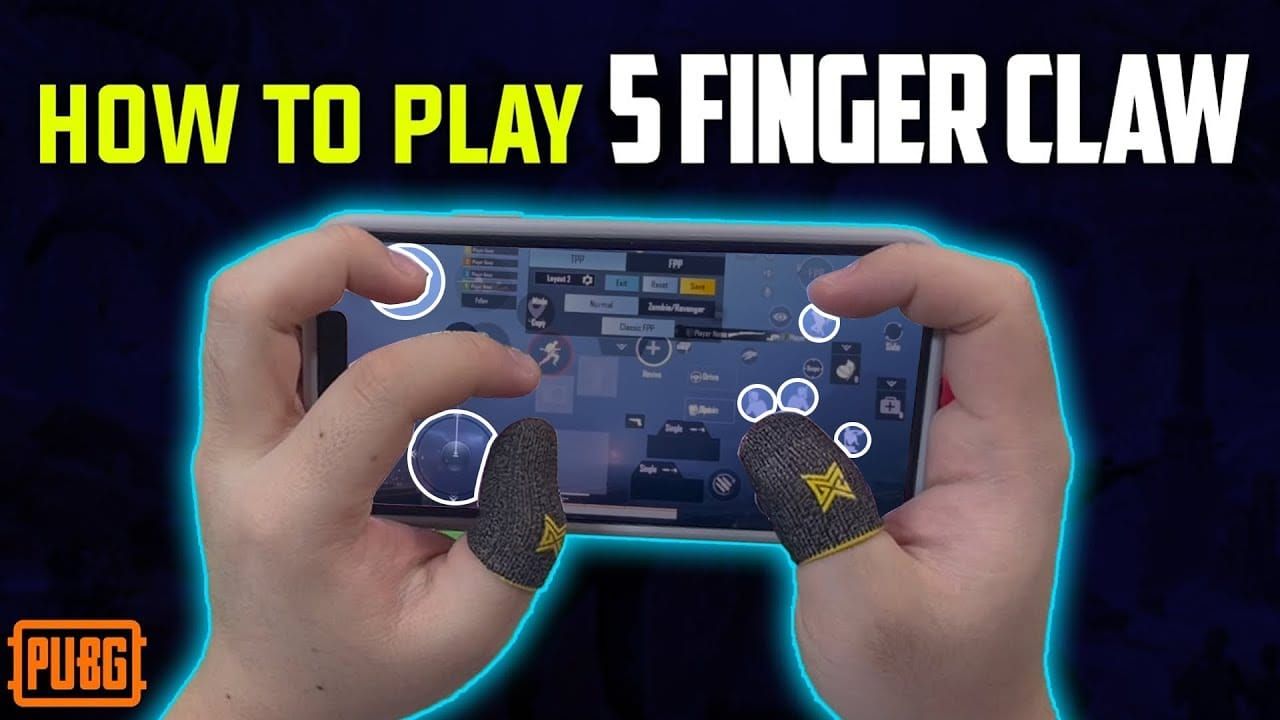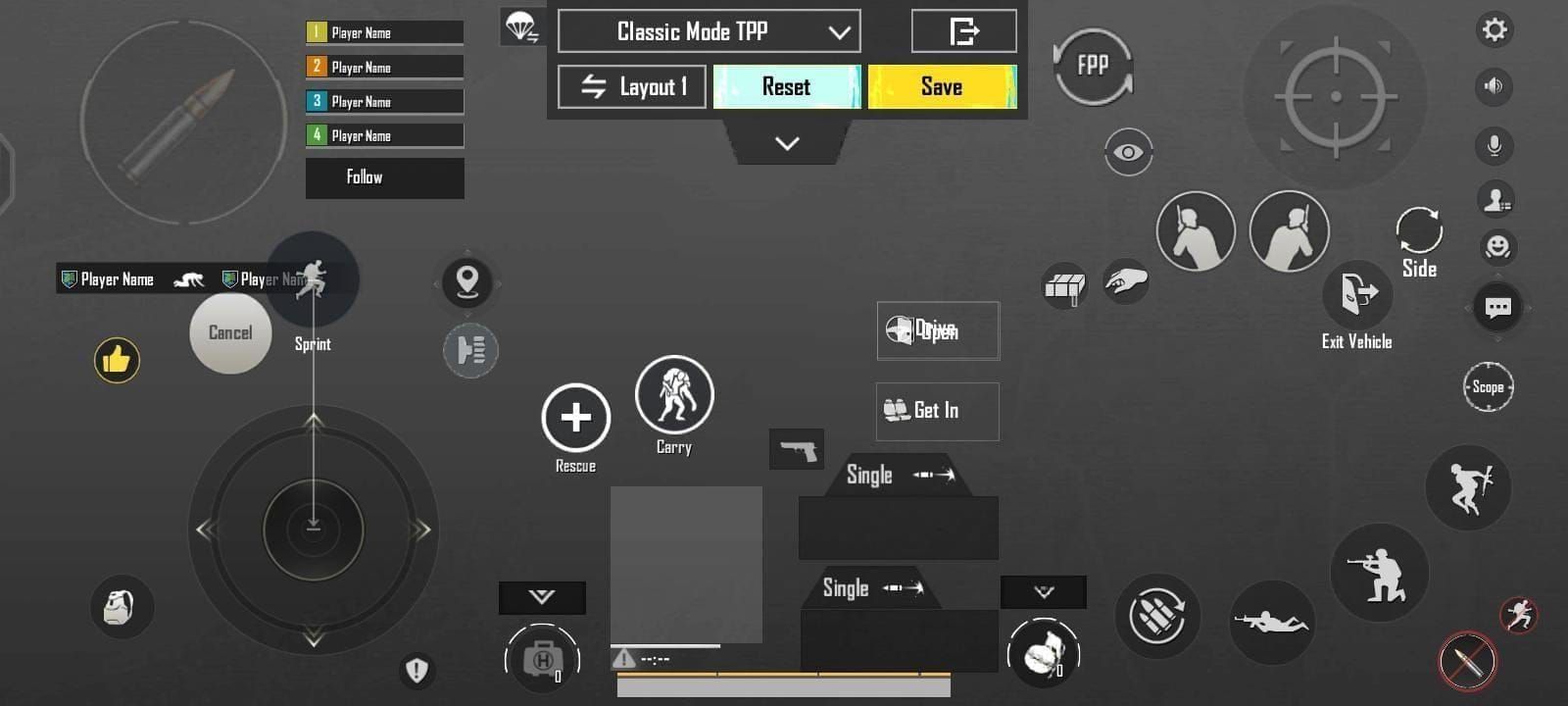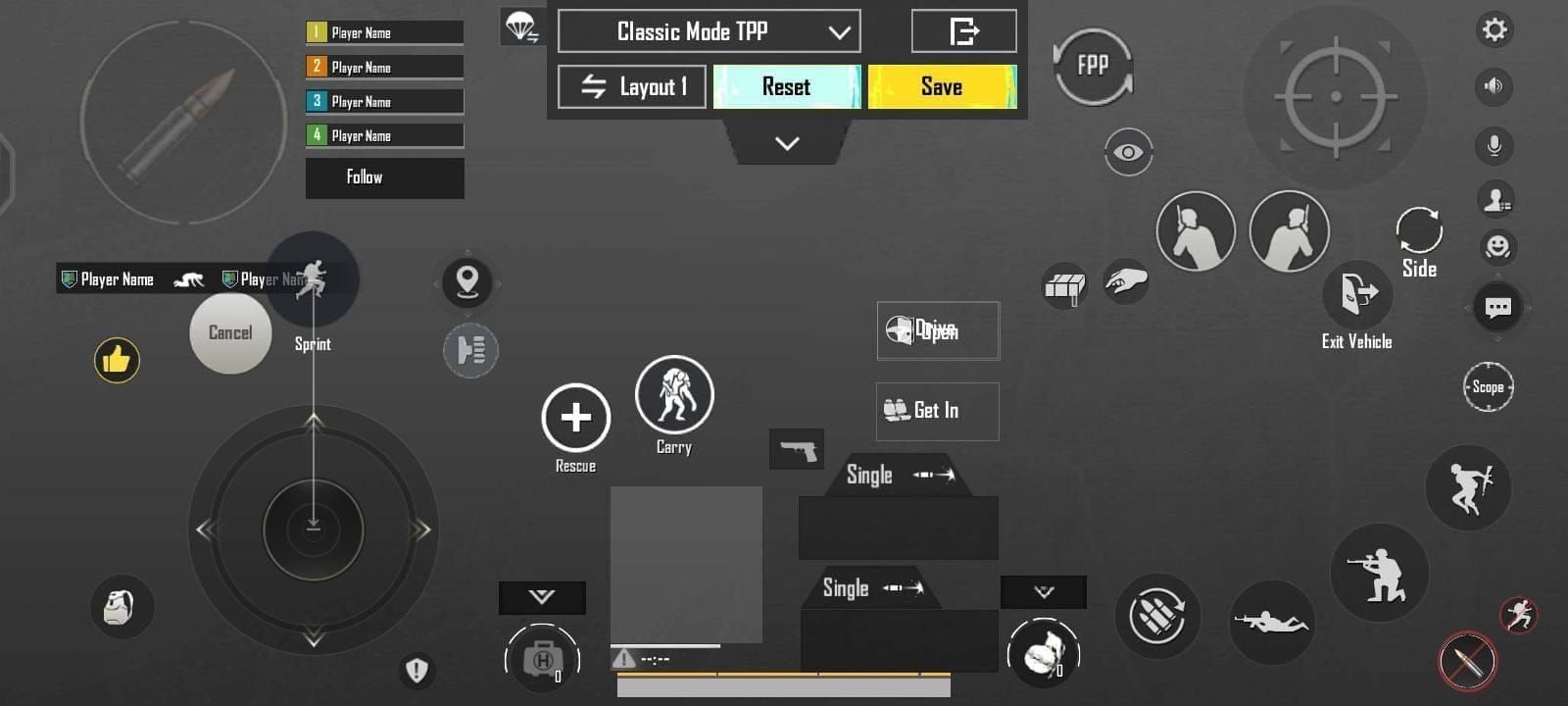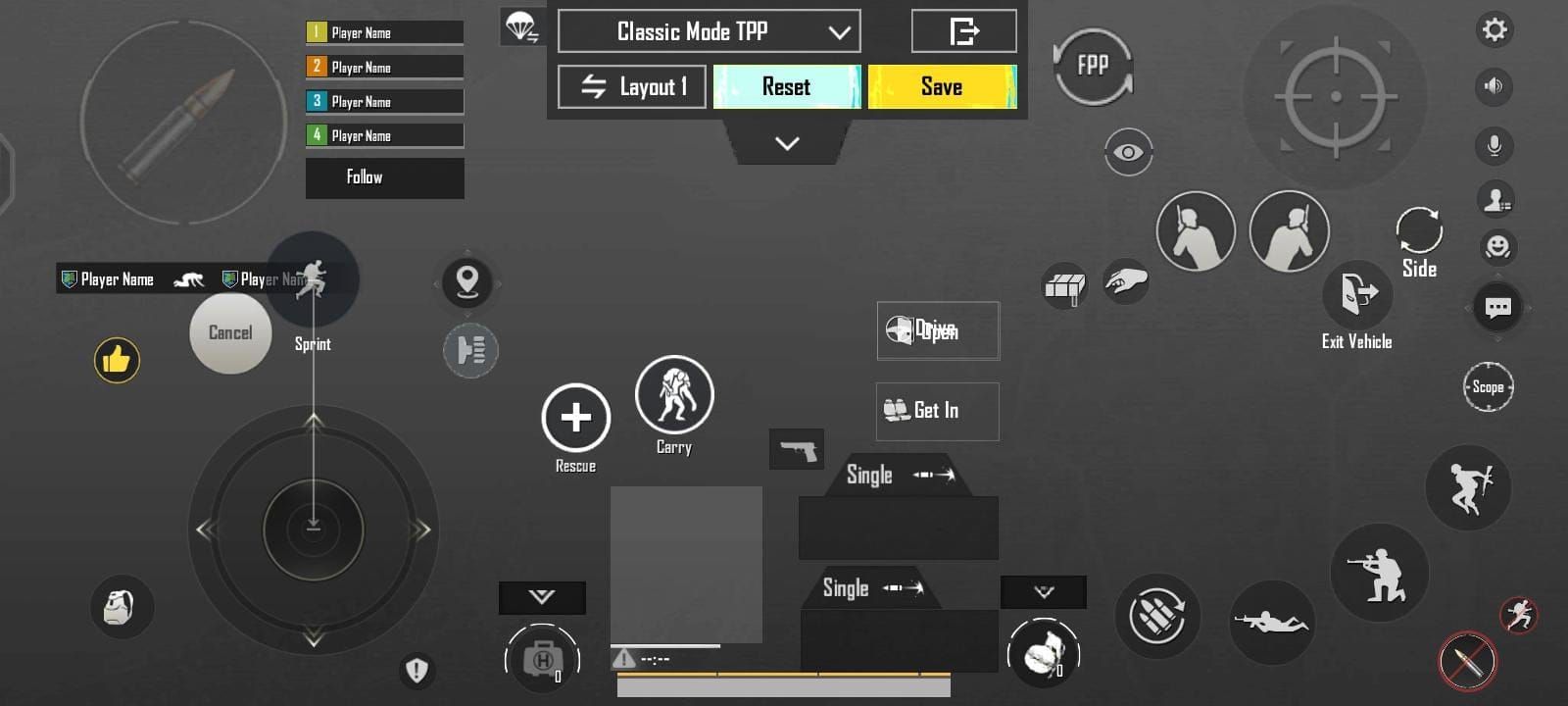Master competitive PUBG Mobile gameplay with proven 4-finger claw layouts used by pro players. This guide covers essential HUD codes, sensitivity configurations, and setup processes to achieve 30-50% performance improvements in ranked matches.
Understanding 4-Finger Claw Grip in PUBG Mobile
What is 4-Finger Claw Grip
Here's where things get interesting. The 4-finger claw grip fundamentally changes how you interact with PUBG Mobile – your thumbs handle movement and aiming while your index fingers take over firing, scoping, peeking, and jumping.
What makes this revolutionary? You can pull off simultaneous actions that are literally impossible with traditional thumb controls. Think crouch-firing while maintaining laser-precise aim, or executing those satisfying jump-shots mid-firefight that make opponents rage-quit.

Professional players consistently demonstrate something remarkable: 4-finger claw enables simultaneous ADS + crouch + shoot combinations, resulting in 40% faster reaction times compared to thumb-only controls. The natural progression most players follow goes like this: 2-finger casual → 4-finger competitive → 6-finger tournament level.
(Editor's note: I've been covering mobile gaming for years, and the skill gap between claw and thumb players is honestly staggering once you see it in action.)
For optimal UC management during your competitive journey, PUBG Mobile UC instant recharge through BitTopup ensures you never miss battle pass rewards or premium cosmetics. BitTopup offers instant delivery with competitive pricing and 24/7 customer support.
Advantages Over Other Control Methods
Let's talk numbers – because the data doesn't lie.
Statistical analysis reveals 4-finger claw players achieve 15-25% higher average damage and literally double their headshot rates compared to thumb users. Here's what the performance metrics actually show:
Reaction Speed: 40% faster response times in close-quarters combat
Accuracy Improvement: 15-25% increase in hit registration
Tactical Versatility: Ability to perform 6+ simultaneous actions
Recoil Management: Superior spray control through dedicated finger assignments
The difference becomes obvious once you watch a skilled claw player in action. They're not just playing the same game better – they're playing a fundamentally different game.
When to Use Claw vs Other Grips
Screen size matters more than most people realize. Devices between 5.5-6.5 inches accommodate 4-finger claw effectively, while larger displays (6.7+ inches) can support advanced 6-finger configurations.
Players with shorter fingers benefit from 3-4 finger configurations on compact screens. Longer reach? You can utilize full 6-finger layouts on larger devices. The learning curve spans 3-4 days for basic proficiency and 2-3 weeks for competitive mastery.
Fair warning: expect your performance to tank initially. It's normal.
Essential HUD Layout Principles for Claw Players
Button Placement Fundamentals
Getting button placement wrong will sabotage your entire setup – I've seen too many players struggle with poorly configured layouts.
Optimal 4-finger claw layouts require fire buttons sized 120-140% of default with minimum 15% spacing between elements to prevent accidental touches. Essential placement guidelines include:

Fire Button: Top-left corner, large size with adequate spacing
Scope Controls: Top-right cluster, separated by function
Peek Buttons: Adjacent to scope area, smaller size to prevent accidents
Movement Actions: Bottom zones accessible to thumbs
Reachability and Comfort Zones
Button clusters should align with natural finger arcs. Overextension causes strain and kills your performance over extended sessions.
Device-specific adjustments:
Small Screens (≤6 inches): Compact button placement, 90-95% sizing
Medium Devices (6-6.5 inches): Balanced spacing, standard sizing
Large Screens (6.7+ inches): Expanded layouts, 130-150% button sizes
Visual Clarity Optimization
Transparency settings between 60-80% offer optimal balance between button visibility and screen clarity. You need to see your buttons without blocking crucial battlefield information.
Priority elements receive enhanced visibility:
Primary Fire: High opacity, distinct color
Secondary Actions: Medium transparency
Utility Functions: Lower opacity, minimal obstruction
Pro Player 4-Finger Claw Layouts and Codes
PMGC Champions Control Setups
Tournament-level players utilize refined 4-finger configurations optimized for competitive play. The code 7275-1794-4178-8556-303 represents the current 2025 meta standard, supporting advanced recoil management and hitbox manipulation techniques.

This isn't just another random layout – it's battle-tested at the highest level.
Alternative proven codes:
6974-6998-1946-2820-026: Balanced setup for medium-large phones
6960-4897-8808-0654-298: AR-optimized with enhanced scope switching
6960-4897-8808-0564-299: Sniper-focused layout for precision gameplay
Popular Streamer Layouts
Jonathan Gaming's aggressive 4-finger setup emphasizes high-sensitivity camera movements with 300% ADS Red Dot settings, enabling rapid target acquisition during rushing tactics. ScoutOP takes a different approach – his hybrid setup balances precision and speed with 55-60% Red Dot ADS and 30-35% 3x scope sensitivity.
Different playstyles, different configurations. That's the beauty of customization.
For consistent performance across all matches, PUBG Mobile UC low price top up via BitTopup ensures you maintain premium account benefits. BitTopup's secure payment processing makes UC purchases hassle-free, allowing you to focus on perfecting your claw technique.
Regional Meta Differences
Here's something fascinating: Asian professional scenes favor aggressive high-sensitivity configurations, while Western competitive play emphasizes precision-oriented setups. Cultural differences in gaming approach actually show up in the data.
The 5-finger variant code 7275-2058-0453-0602-607 used by Fnatic players demonstrates advanced techniques adaptable to 4-finger configurations through simplification.
Complete Sensitivity Settings Guide
Camera Sensitivity Optimization
Getting sensitivity right is crucial – too high and you'll overshoot targets, too low and you'll get outmaneuvered.
Optimal ranges for competitive play span 190% for 3rd Person No Scope and 130% for 1st Person No Scope. Recommended camera configurations:

3rd Person No Scope: 190-200%
1st Person No Scope: 130-150%
Free Look: 150% for enhanced situational awareness
Camera (Character): 100-120% for balanced movement
ADS and Scope Settings
ADS sensitivity follows a cascading principle – decreasing with magnification levels to maintain consistent muscle memory. This isn't arbitrary; it's based on how your brain processes different zoom levels.
Proven ADS configurations:
Red Dot/Holographic: 50-60%
2x Scope: 35-45%
3x Scope: 25-35%
4x Scope: 20-30%
6x Scope: 15-23%
8x Scope: 10-15%
Gyroscope Integration
Gyroscope sensitivity enhances 4-finger claw precision through device tilting for vertical recoil control. Many players ignore this feature, but it's a game-changer for recoil management.
Optimal gyroscope settings:
No Scope to 2x: 300-400%
3x Scope: 240-300%
4x Scope: 200-210%
6x Scope: 100-170%
8x Scope: 50-100%
Device-Specific Setup Recommendations
iPad Optimization
Tablets excel with 4-finger claw due to expanded screen real estate. The extra space transforms your entire approach to button placement.
iPad-specific adjustments:
Button Sizing: 130-150% for improved accuracy
Spacing: 20-25% to prevent accidental touches
Layout Distribution: Utilize screen edges effectively
Sensitivity Boost: +10-15% camera for aggressive play
Android Phone Layouts
Android devices require careful optimization based on screen size and touch latency characteristics. Not all Android phones are created equal – budget devices need conservative settings while gaming phones can handle aggressive configurations.
Android optimization guidelines:
Budget Devices: Conservative settings, larger buttons
Gaming Phones: +20-30% camera sensitivity
High Refresh Rate: +10-15% sensitivity adjustment
Curved Edges: Careful placement for Samsung Galaxy series
iPhone Specific Settings
iOS devices typically require +5-10% ADS sensitivity adjustments due to screen calibration differences. Apple's touch implementation differs slightly from Android.
iPhone configuration tips:
Standard Models: Maximum 4-finger, 90-95% button sizing
Pro Max: 5-finger possible with customization
Screen Edge Utilization: Minimize display obstruction
iOS Calibration: +5-10% ADS sensitivity compensation
Step-by-Step HUD Customization Process
Initial Setup and Import
The import process begins through Settings → Customize Buttons → Customize → Layout Management → Search Method. Paste your desired code (such as 7275-1794-4178-8556-303) and search to apply the configuration.
Import procedure:
Access Settings: Navigate to Customize Buttons section
Select Layout Management: Click the layout management icon
Choose Search Method: Select code import option
Paste Code: Enter the desired layout code
Apply Configuration: Confirm and test the new layout
Fine-tuning for Personal Preference
Post-import customization involves incremental adjustments of 1-2% to optimize button placement for individual hand size and device characteristics. Small tweaks make huge differences.
Customization priorities:
Button Positioning: Adjust for natural finger reach
Size Optimization: Scale based on accuracy requirements
Spacing Refinement: Prevent accidental activation
Transparency Settings: Balance visibility and clarity
Testing and Validation
Validation occurs through structured testing in Training Ground and Team Deathmatch modes. Don't jump straight into ranked – you'll regret it.
Testing protocol:
Training Ground: 15 minutes spray control practice
TDM Sessions: 30 minutes muscle memory development
Ranked Validation: Apply after 3-4 days basic mastery
Performance Tracking: Monitor K/D and accuracy improvements
Training and Muscle Memory Development
Progressive Learning Exercises
Muscle memory development follows a structured timeline spanning 3-4 weeks for complete mastery. Patience is key here – rushing the process only delays your progress.
Training phases:
Week 1: Basic familiarization, 20-30% performance drop expected
Week 2: Movement-combat integration, baseline recovery
Week 3: Advanced maneuvers, 15-25% improvement begins
Month 2+: Instinctive play, 30-50% performance gains
Common Beginner Mistakes
Overcrowded HUD layouts represent the most frequent error in 4-finger claw adoption. I see this constantly – players think more buttons equals better performance.
Critical mistakes to avoid:
Insufficient Spacing: Causes accidental button activation
Oversized Elements: Obstructs battlefield visibility
Inconsistent Sizing: Disrupts muscle memory formation
Poor Ergonomics: Leads to hand fatigue and performance decline
Advanced Techniques
Advanced 4-finger techniques include simultaneous movement + aim + fire + crouch combinations that provide competitive advantages. When you can execute these instinctively, you've reached the next level.
Mastery indicators:
Simultaneous Actions: 4+ concurrent inputs without errors
Spray Consistency: Tight groupings across all weapon types
Reaction Speed: Sub-200ms target acquisition
Tactical Execution: Complex maneuvers under pressure
Performance Optimization and Troubleshooting
Lag and Responsiveness Issues
Input lag troubleshooting begins with graphics optimization: set Smooth quality with maximum FPS (Ultra/90Hz when available). Performance issues will kill your claw technique faster than anything else.
Optimization checklist:
Graphics Settings: Smooth quality, maximum FPS
Background Apps: Close unnecessary processes
Device Temperature: Monitor for thermal throttling
Touch Sensitivity: Adjust for device-specific characteristics
Hand Comfort and Ergonomics
Extended 4-finger claw sessions require attention to hand health and comfort. Trust me on this – hand strain isn't worth the competitive edge.
Ergonomic considerations:
Break Schedule: 5 minutes every 30 minutes
Hand Position: Natural finger curves, avoid overextension
Device Support: Use stands or grips to reduce holding strain
Finger Exercises: Stretching between sessions
Maintenance and Updates
Regular layout maintenance involves weekly sensitivity reviews and post-update recalibration. Game updates can mess with your carefully tuned settings.
Maintenance routine:
Weekly Reviews: Assess performance metrics and adjust accordingly
Update Preparation: Backup configurations before patches
Sensitivity Tracking: Document changes for rollback capability
Meta Adaptation: Adjust for weapon balance changes
Competitive Advantages and Meta Adaptation
Situational Layout Switching
Advanced players maintain multiple layout configurations for different game modes and situations. One size doesn't fit all in competitive gaming.
Layout specializations:
Classic Mode: Balanced for all engagement ranges
Arena/TDM: Close-quarters optimized
Sniper Focus: Long-range precision emphasis
Aggressive Rush: High-sensitivity rapid movement
Game Mode Specific Adjustments
Different game modes require tactical layout modifications. What works in classic might be terrible in arena.
Mode-specific priorities:
Classic: Balanced combat and survival tools
Arena: Maximum combat efficiency
Payload: Vehicle and heavy weapon controls
Metro: Inventory and extraction focus
Future-Proofing Your Setup
Meta evolution requires adaptable configuration strategies. The game changes – your setup should evolve with it.
Future-proofing strategies:
Pro Player Monitoring: Track tournament configuration changes
Community Engagement: Participate in strategy discussions
Experimental Testing: Try new techniques in casual modes
Backup Maintenance: Preserve working configurations during experimentation
FAQ
How long does it take to master 4-finger claw in PUBG Mobile? Basic proficiency requires 3-4 days with 30-45 minutes daily practice. Competitive mastery takes 2-3 weeks, with initial 20-30% performance drops followed by 30-50% improvements after full adaptation.
What's the best 4-finger claw layout code for 2025? Code 7275-1794-4178-8556-303 represents the current meta standard. Alternative codes include 6974-6998-1946-2820-026 for balanced setups and 6960-4897-8808-0654-298 for AR-focused gameplay.
Which sensitivity settings work best with 4-finger claw? Use cascading ADS sensitivity: Red Dot 50-60%, 2x 35-45%, 3x 25-35%, 4x 20-30%, 6x 15-23%, 8x 10-15%. Combine with 300-400% gyroscope for close-range and 190% camera sensitivity.
Can I use 4-finger claw on small phones? Devices 5.5-6.5 inches support 4-finger claw effectively. Use 90-95% button sizing with compact placement. iPhone and smaller Android devices work best with 3-4 finger configurations.
How do I import pro player HUD codes? Navigate to Settings → Customize Buttons → Customize → Layout Management → Search Method. Paste the code, search, and apply. Always backup current settings first.

What devices are best for 4-finger claw gameplay? Gaming phones 6.1+ inches with high refresh rates (90/120Hz) provide optimal performance. iPad and tablets excel with expanded layouts, while iPhone Pro Max models can accommodate 5-finger configurations.

